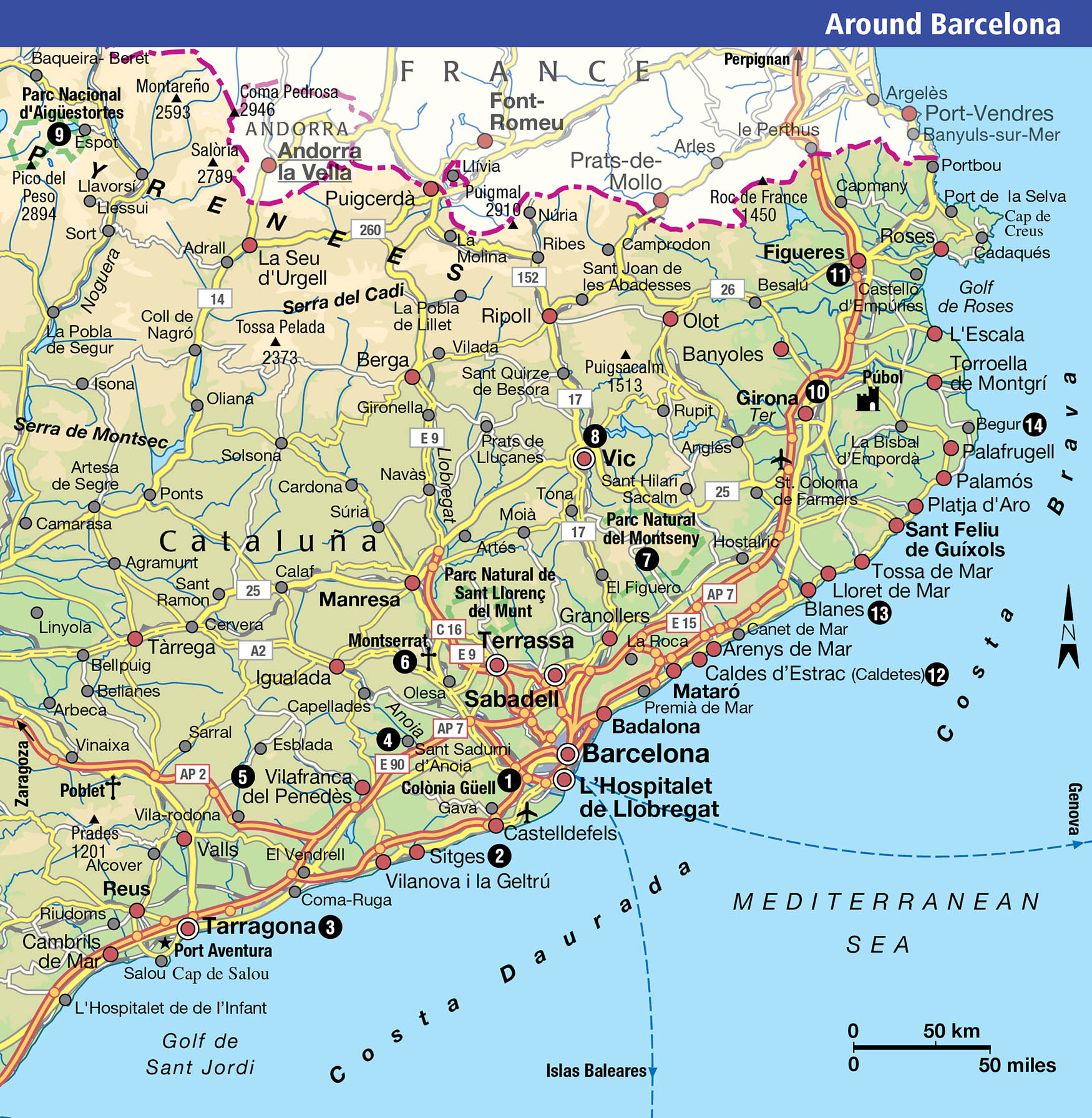Maps and Listings
Barcelona is a great city to be in, but there are also beaches, mountains, wine country, religious retreats and historic provincial cities all within relatively easy reach. Travelling to and from the city by hire car is best avoided in weekday rush hours, Friday and Sunday evenings and at the start and end of Christmas, Easter and August holidays. Visitors who travel outside these times will enjoy straightforward, stress-free journeys. Travelling by train and bus is also manageable from the city.

Barefoot on Sitges’ promenade.
Corrie Wingate/Apa Publications
Excursions
Some of these excursions are day trips but it would be worth taking two or three days for the longer ones.
There are two options for journeys to the south of Barcelona (Sitges and Tarragona), two to the west (the Penedès region and Montserrat), three inland to the north (Montseny, Vic and the Pyrenees), two up into the province of Girona (Figueres and Girona), one to the Maresme coast just north of Barcelona (Caldetes), and one to the Costa Brava.
Sitges, Caldetes and the Costa Brava all have fine beaches; Montserrat, the Montseny and the Pyrenees are mountain-top retreats; Vic, Tarragona, Figueres and Girona are historic provincial centres.
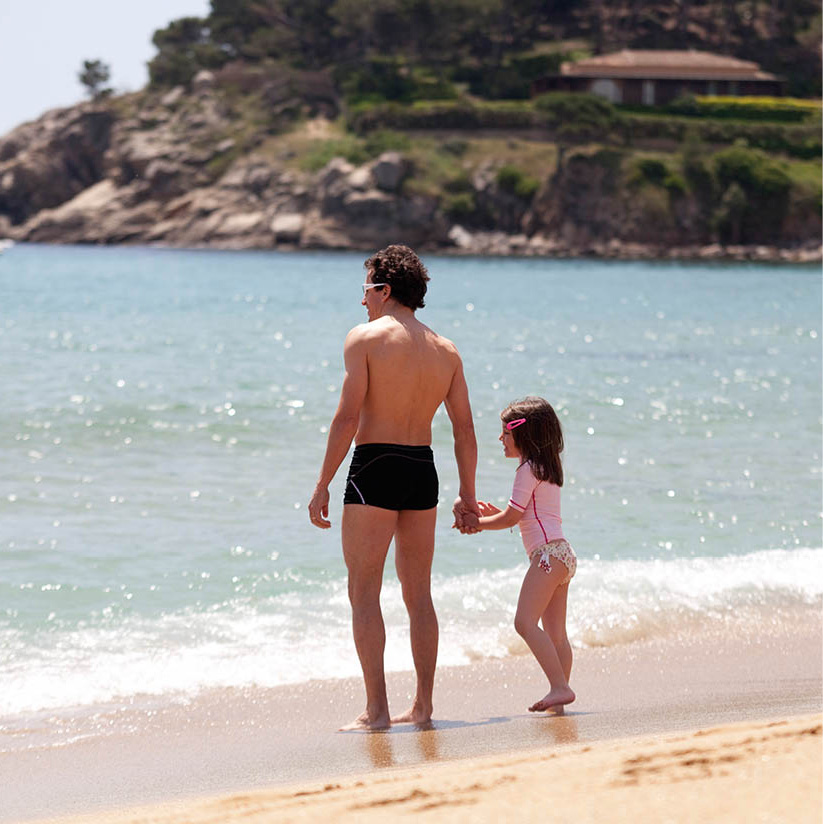
The Costa Brava is popular for family holidays.
Corrie Wingate/Apa Publications
Colònia Güell 1 [map]
Address: Santa Coloma de Cervelló; www.gaudicoloniaguell.org
Tel: 93-630 5807
Opening Hrs: summer Mon–Fri 10am–7pm, winter until 5pm, Sat–Sun 10am–3pm
Entrance fee: charge for church
Transport: FGC trains from Plaça d’Espanya to Colònia Güell station
One easy trip that can be done in half a day is to the Colònia Güell in Santa Coloma de Cervellò. This 19th-century textile-industry estate, with a church crypt designed by Antoni Gaudí, is a fascinating place. The crypt, named a World Heritage site in 2005, is a must for Gaudí enthusiasts, illustrating his ingenious building techniques and fantastical decorative ideas. It is worth getting the audioguide to capture the wealth of details and to be guided round the interesting buildings in the village, though they are not open to the public.
Tip
Using a T10 metro card (zone 1) you can travel up the coast on a train as far as Montgat Nord (a favourite for surfers) or down to Platja de Castelldefels (and even the airport).
Sitges 2 [map]
A smooth 40-minute train ride or a quick drive through the Garraf tunnels on the C32 motorway will whisk you south to Sitges, the closest clean and uncrowded bit of the Mediterranean coast. Sand and sun can be enjoyed at Castelldefels, 20 minutes from Barcelona, but the whitewashed houses and flower-festooned balconies of Sitges are worth the extra journey time, making you feel a world away. A day on the beach, with a paella for lunch, is a great idea. What’s more, the weather is reputed always to be better in Sitges, so you could leave Barcelona in cloud and arrive to find glorious sunshine.
An international party atmosphere pervades Sitges in summer, and the town has a full calendar of festivals year round, including a notoriously wild Carnival, thanks to its gay community, and an International Film Festival in October.
The beaches are fringed by palms and an elegant promenade. They start on the other side of the 17th-century Església Sant Bartomeu i Santa Tecla, on the headland, and extend south past the Hotel Terramar.
Museu Romàntic Can Llopis
Address: Sant Gaudenci, s/n; www.museusdesitges.com
Opening Hrs: summer Tue–Sat 10am–2pm, 4–8pm, Sun 10am–3pm, winter Tue–Sat 10am–2pm, 3.30–7pm, Sun 11am–3pm
The Museu Romàntic Can Llopis gives a good insight into the life of a 19th-century bourgeois family in this handsome building and also houses the Lola Anglada antique-doll collection. Also in Sitges, in Fonollar street, the atmospheric Museu Cau Ferrat, studio-home of Santiago Rusiñol, leading light in the modernista movement, is due to reopen after extensive refurbishment. Containing a huge collection of art, glass and ceramics, it is very evocative of the period. Check the above website for opening times.
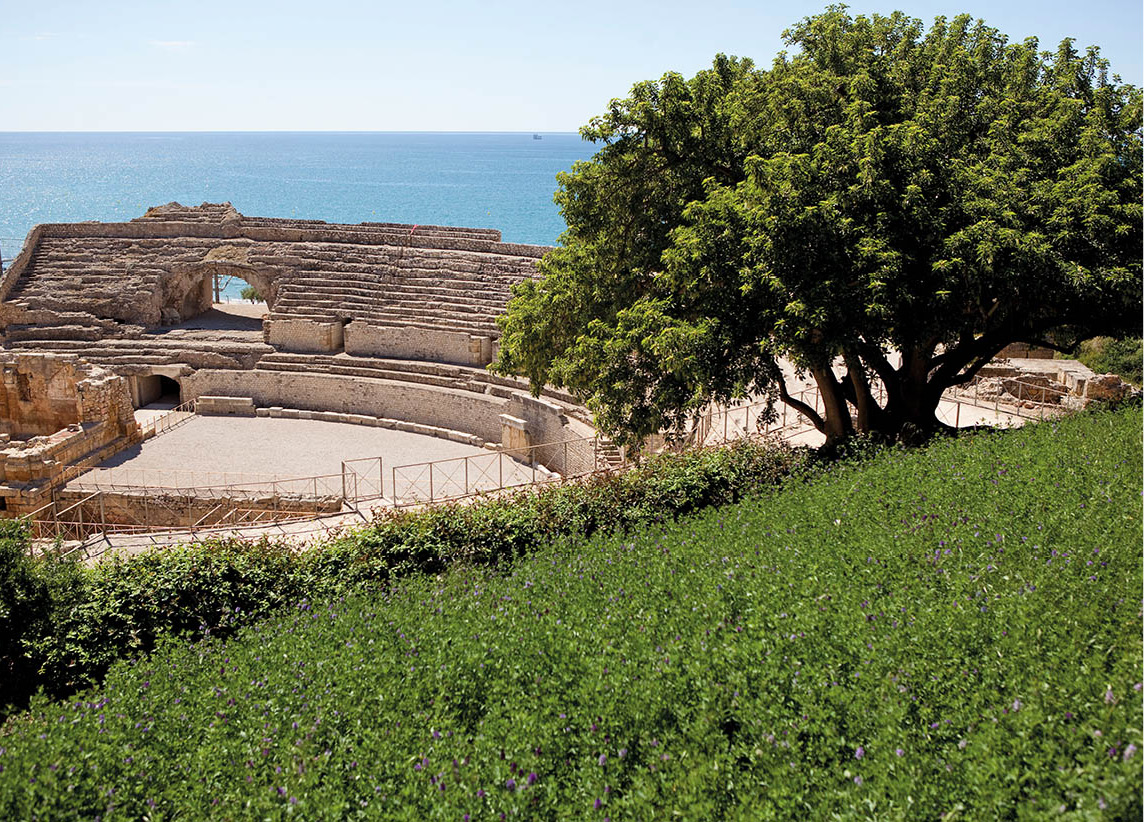
Tarragona’s Roman amphitheatre.
Corrie Wingate/Apa Publications
Tarragona 3 [map]
Around 90 minutes from Barcelona by train or car, Tarragona still has the feel of a provincial capital of the Roman Empire. Captured by Rome in 218BC and later the capital of the Spanish province of Tarraconensis under Emperor Augustus, the town was the major commercial centre until Barcelona and Valencia overshadowed it following the Christian Reconquest in the early 12th century.
Rich in Roman ruins still being unearthed and stunningly beautiful ancient buildings, it was declared a World Heritage site in 2000.
The cathedral
Tarragona’s cathedral, the centrepiece of the top part of the city, has been described by Catalonia’s own travel writer Josep Pla as ‘easily and serenely mighty, solid as granite, maternal – a cathedral redolent of Roman virtues projected onto carved stone – a lion in repose, drowsy, unabashedly powerful.’
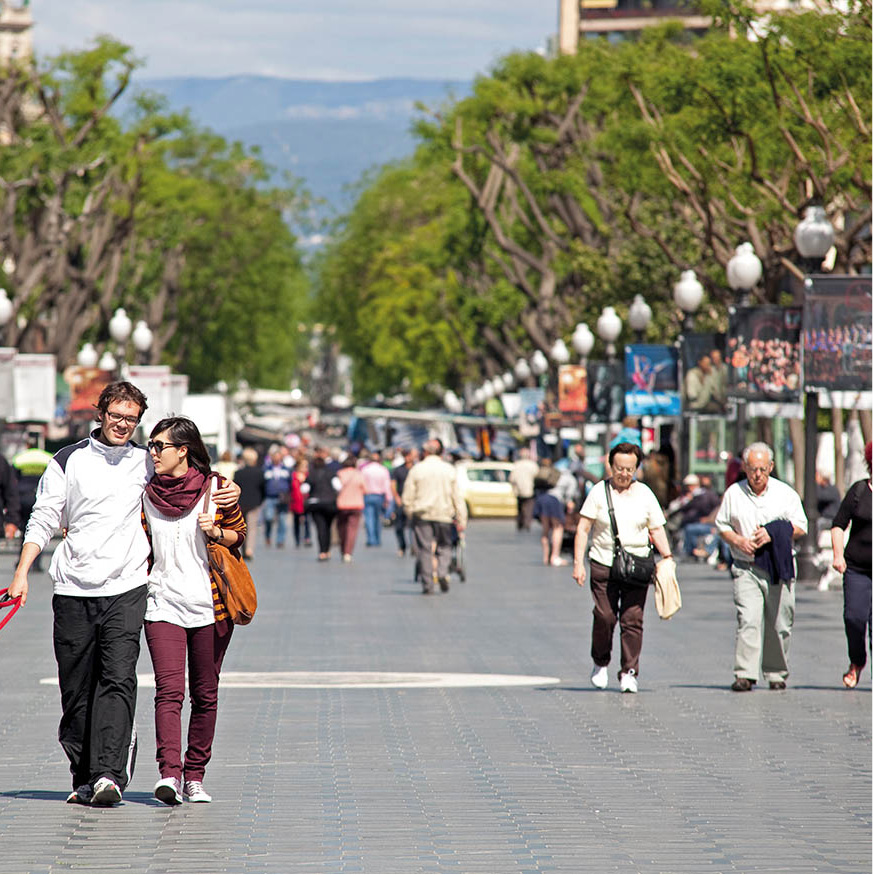
On Tarragona’s Rambla.
Corrie Wingate/Apa Publications
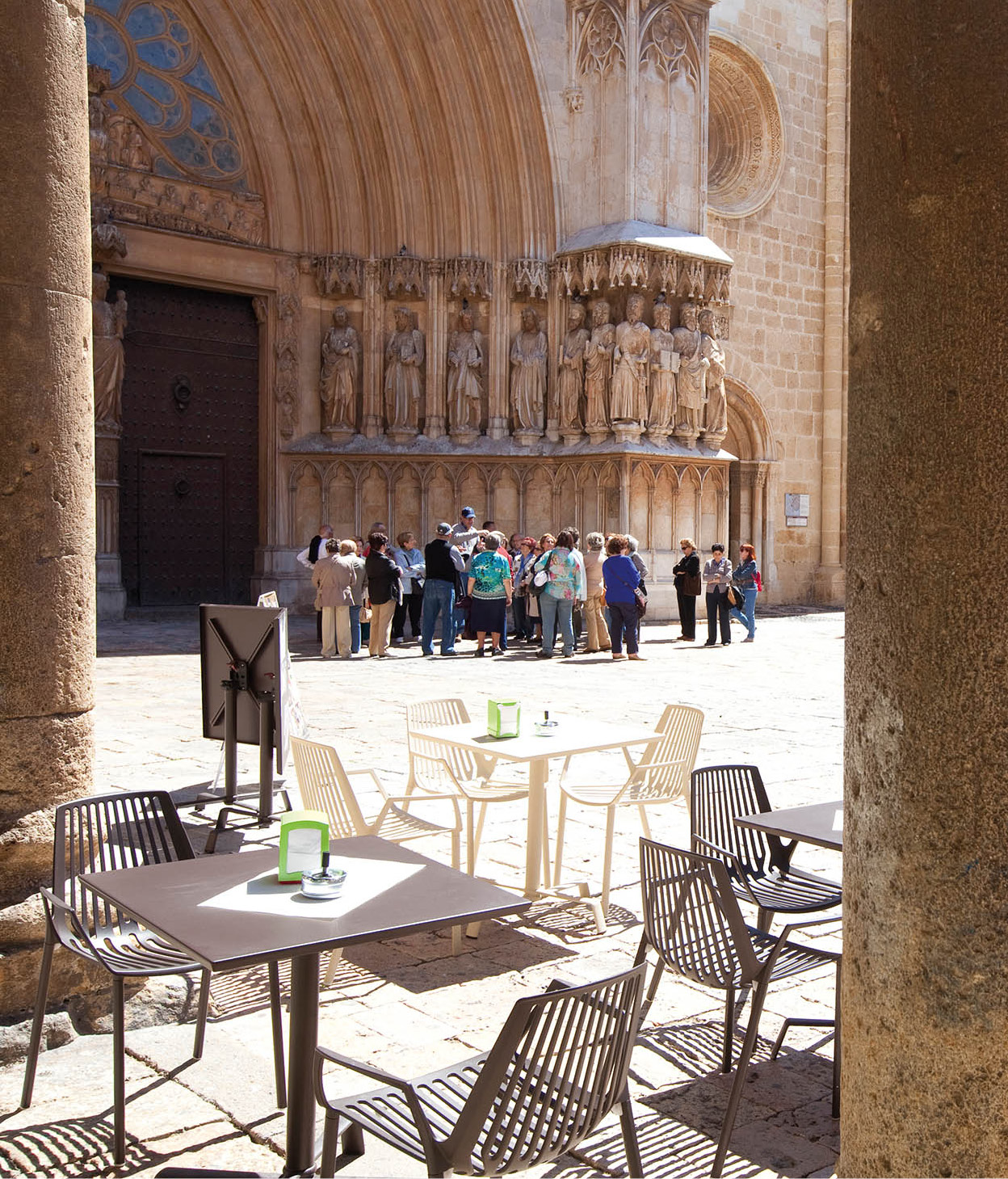
Café outside Tarragona’s splendid cathedral.
Corrie Wingate/Apa Publications
Passeig Arqueològic
Explore the walled upper part of the city surrounding the cathedral, then tour the wall itself, the Passeig Arqueològic (Archaeological Promenade; (www.tarragonaturisme.cat). It offers views south over the city, west out to the mountains, north to the hills and trees surrounding the city, and finally east to the coastline and sea.
Below the walls is the middle section of Tarragona, with the wide and stately Rambla ending in the Balcó del Mediterrani (Mediterranean Balcony) looking over the beach, port and impressive Roman amphitheatre. The city’s luminosity at this point has been much commented on and is indeed remarkable: a crisp elegance and clean air shimmer over the golden sandstone of 2,000-year-old Roman structures.
The port
The Serrallo section of the port is the main attraction in the lower part of the city, the multicoloured fishing fleet unloading their catch every afternoon, the fish auctioned off within minutes. A lunch at a dockside restaurant – featuring fine Tarragona wines and seafood just out of the nets – makes a delicious end to a visit.
Salou and Port Aventura
Just 8km (5 miles) south of Tarragona is the seaside resort of Salou and its neighbouring theme park Port Aventura, the largest in Europe after Disneyland Resort Paris (www.portaventura.es; end Mar–end Oct daily, Nov–Dec Fri–Sun only; see website to confirm opening times; charge). People travel for miles to experience the thrills and spills it offers. There are several hotels on the site and a new golf course.

Sant Sadurní d’Anoia produces 80 percent of Spain’s cava.
Gregory Wrona/Apa Publications
Sant Sadurní d’Anoia 4 [map]
If you wish to experience the more indigenous pleasures of Catalonia, the Penedès wine-growing region can be easily reached from the city. Begin in Sant Sadurní d’Anoia, a small town responsible for 80 percent of cava production, the sparkling wine made in Catalonia.
A 45-minute train ride from Sants or Plaça de Catalunya stations in Barcelona will drop you in Sant Sadurní, right next to Freixenet, the world’s leading producer of cava, with vineyards in California and operations in China.
Cava has been produced in Sant Sadurní since 1872 by Josep Raventós, founder of the Codorníu empire, who studied the méthode champenoise of Dom Pérignon and made Catalonia’s first bottle of cava. It is an important part of life in Catalonia: baptisms, weddings, even routine Sunday lunches are occasions for popping corks. On 20 November 1975, the day Franco died, cava was given away free in Barcelona.
Eat
Sant Sadurní offers excellent gastronomic opportunities at local restaurants well known for fine cava and seafood. Between late January and mid-March, the calçotada is a traditional feast starring long-stemmed calçots (something between a spring onion and a leek), dipped in a romesco sauce of oil, peppers, garlic and ground nuts. Cava flows freely at these rustic banquets, accompanied by lamb or rabbit grilled, as are the calçots, over coals.
Vilafranca del Penedès 5 [map]
About 14km (8 miles) from Sant Sadurní is Vilafranca del Penedès. The Penedès region has more than 300 wine and cava-producing companies, most of which can be visited, including the winery and extensive vineyards of the world-famous Torres, which dominates the region. Information is centralised through the tourist office in Vilafranca (tel: 93-818 1254; http://turisme.vilafranca.cat). Around Sant Sadurní even children have opinions on bruts, secs and brut natures.

The Vinseum, Vilafranca del Penedès.
Vinseum
Vinseum: Museu de les Cultures del Vi de Catalunya
Address: Plaça Jaume I, Vilafranca del Penedès; www.vinseum.cat
Tel: 93-8900 582
Opening Hrs: Tue–Sat 10am–2pm and 4–7pm, Sun 10am–2pm
Entrance fee: charge
One of Europe’s best wine museums, explaining the history of wine in Catalonia, has reopened in a renovated 13th-century palace, displaying its interesting collection of over 17,000 objects related to wine.
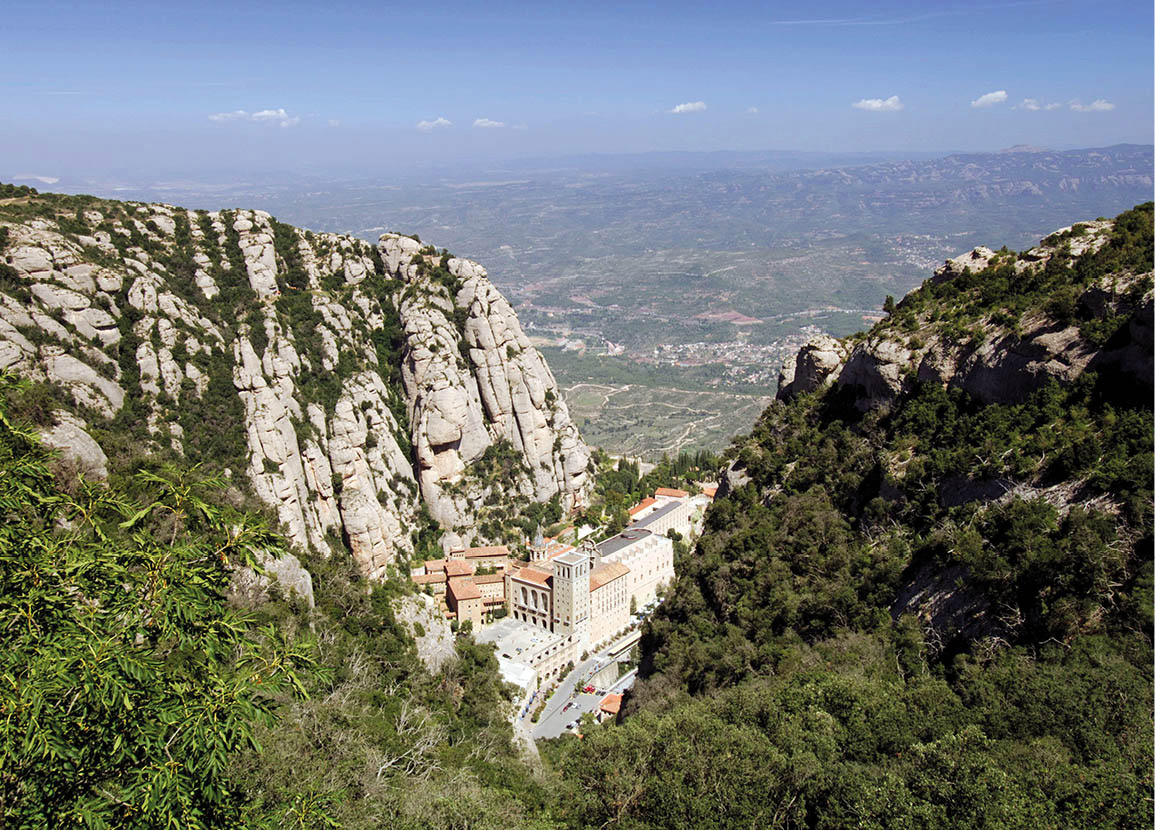
Looking down on the monastery at Montserrat.
Gregory Wrona/Apa Publications
Montserrat 6 [map]
Address: www.montserratvisita.com
Tel: 93-877 7701
Opening Hrs: Basilica daily 7.30am–8pm, museum daily 10am–5.30pm, closes slightly later in mid-summer
Entrance fee: free; charge for museum
Transport: FGC Plaça Espanya to Aeri de Montserrat (for cable car) or Monistrol de Montserrat for Cremallera (zip-train)
Situated 48km (30 miles) west of Barcelona, and looming 1,236 metres (4,055ft) over the valley floor, Montserrat, the highest point of the lowlands, is Catalonia’s most important religious site (for more information, click here). Here athletes pledge to make barefoot pilgrimages if their prayers are answered and vital competitions won. Groups of young people from all over Catalonia make overnight hikes at least once in their lives to watch the sunrise from the heights.
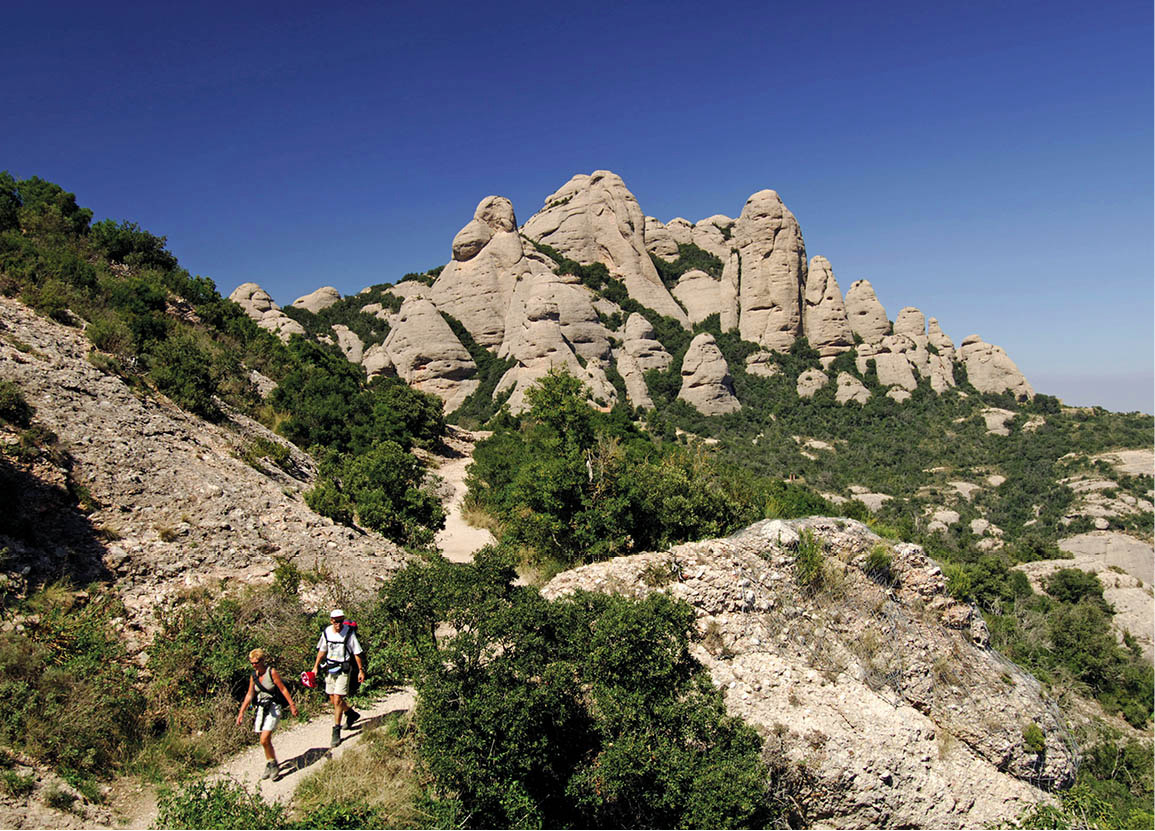
The Parc Natural de Montseny.
Gregory Wrona/Apa Publications

Inside the basilica at Montserrat.
Gregory Wrona/Apa Publications
‘La Moreneta’ (the Black Virgin), said to have been made by St Luke and brought to Barcelona by St Peter, resides in the sanctuary of the Mare de Deu de Montserrat. There is a separate door at the front of the basilica for people wanting to see and touch this statue of Madonna and Child, but be prepared to queue.
Montserrat can be reached easily and spectacularly by train, but the advantage of going by car is the opportunity of seeing it from different angles. In the words of Catalan poet Maragall, from varying perspectives Montserrat resembles ‘a bluish cloud with fantastic carvings, a giant’s castle with 100 towers thrown towards the sky… above all an altar, a temple’.
The basilica is packed with works by prominent painters and sculptors, including paintings by El Greco in the sanctuary’s museum. Catalan poets have dedicated some of their most inspired verse to Montserrat, while maestros such as Nicolau and Millet have composed some of their finest pieces in its honour. Goethe is said to have dreamed of Montserrat, and Parsifal sought the Holy Grail here in Wagner’s opera.
Excursions
There are several excursions to be made from the monastery. Via Crucis, the Way of the Cross (behind Plaça de L’Abat Oliba) leads to the hermitage of Sant Miquel. From Plaça de la Cru a cable car runs down to Santa Cova, a chapel in a grotto where the Virgin is said to have been hidden during the Moorish occupation.
On a clear day it is worth taking the funicular (plus a 20-minute walk) up to Sant Joan, one of the 13 ermitas inhabited by hermits until Napoleon’s troops hunted them down and killed them. Montserrat’s highest point is Sant Jeroni, from where Catalonia spreads out before you – the view sometimes extends as far as Mallorca.
Montseny hills 7 [map]
Montserrat and the Montseny range of mountains in the Parc Natural de Montseny (www.turisme-montseny.com) occupy polar extremes in Catalonian spiritual life. Montserrat is vertical, acute and passionate, Montseny is smooth, horizontal, massive and placid. Seny in Catalan means sense, patience, restraint, serenity, and is a byword for a description of the national characteristics.
Best explored by car, this monumental mountain forest is presided over by four peaks: Turó de l’Home, Agudes, Matagalls (all around 1,500 metres/5,000ft) and Calma i Puigdrau, a lower peak at 1,215 metres (4,050ft). Lesser terrain features and watercourses connect and define these pieces of high ground, tracing out an autonomous geographical entity which always appears mist-enshrouded on the horizon, often confused with cloud formations.
The village of Montseny can be reached via Santa Maria de Palautordera and Sant Esteve de Palautordera on the BV-5301. This road continues on to Brull, through the pass at Collformic and over to Tona, near Vic (for more information, click here), traversing the entire Montseny massif. The road up from Sant Celoni, just off the autovia towards France, via Campins and Fogars de Montclus, arrives at the Santa Fe hermitage, a vantage point which seems only a stone’s throw from Montseny’s highest points. The oaks and poplars are colourful in autumn, which is an unusual sight in Catalonia, where forests of deciduous trees are uncommon.
Tip
A mere 70km (43.5 miles) away from Barcelona, the Montseny range is the perfect rural antidote to the city. A favourite retreat for feeling remote is the much-loved Hotel Sant Bernat, with breathtaking views, traditional mountain fare and – of course – a collection of St Bernard dogs to keep you company.
Vic 8 [map]
An easy hour’s journey north by train or car, Vic (www.victurisme.cat) is an elegant market town with interesting medieval buildings, sophisticated shops and good food. It is the meeting place of industry, commerce and agriculture and a mixture of rural and urban life. With a strong ecclesiastical and cultural tradition, the town is an entity quite distinct from Barcelona, and the Vic accent is unmistakable. The magnificent Plaça Major, surrounded by low arcades, has a lively Saturday market and is a pleasant place to have a drink.
Cathedral
Vic’s cathedral, a neoclassical structure completed in 1803 and with a graceful 11th-century Romanesque bell tower, is best known for Josep Maria Sert’s epic murals covering the interior walls. Sert left his personal vision in the voluptuous, neo-Baroque figures performing colossal deeds. His triptych on the back of the western door depicts the injustices in the life of Christ and, by association, in the history of Catalonia. With the cathedral in ruins as his background, Jesus expels the moneylenders from the temple and is, in turn, condemned to be crucified while Pilate washes his hands and Barabbas, the thief, is cheered by the crowd. Certain faces (Pilate, Barabbas) are said to be those of Franco’s lieutenants, but El Generalísimo himself, visiting while Sert’s work was in progress, did not see the resemblance.
The philosopher Jaume Balmes (1810–48), a native of Vic, is buried in the cloister, as is Sert.
Museu Episcopal
Address: Plaça Bisbe Oliba, 3
Opening Hrs: Tue–Sat 10am–7pm, closed lunchtime Mon–Fri in winter, Sun 10am–2pm
Entrance fee: charge
The museum has a large, impressive collection of Romanesque and Gothic pieces, including altarpieces and sculpted figures collected from local chapels and churches.
Its treasures have now been re-housed in a new building designed by leading Barcelona architects Correa and Milà. Note especially the Romanesque textiles and El Davallament de la Creu (The Descent from the Cross), an especially fine 12th-century sculptural work in polychrome wood.

Aigüestortes National Park.
Fotolia
Although many parts of the Pyrenees can be visited in a day from Barcelona – keen skiers dash up to La Molina for as many downhill runs as they can pack in before returning for dinner on the coast – the Parc Nacional d’Aigüestortes i Estany de Sant Maurici (www.gencat.cat/parcs/aiguestortes), in the province of Lleida, deserves at least two or three days. A three- to four-hour car journey from the city, Catalonia’s only national park is stunningly beautiful and a stimulating antidote to the city. It has some 200 lakes, dramatic peaks, walks for all ages and a rich cultural heritage. Many of the Romanesque pieces of art in the Museu Nacional in Barcelona (for more information, click here) and the Museu Episcopal in Vic came from 11th-century churches that can still be visited in this area.
Espot
The village of Espot makes a good base. It is just outside the Parc, and easily reached on the C13 following the roaring Noguera Pallaresa river, a favourite for whitewater rafting. It has several hotels and some good restaurants serving hearty mountain fare like estofat de porc senglar (wild boar stew). There are easy trails straight from Espot, or from the car park beyond the village. Alternatively, catch a four-wheel drive taxi to take you deeper into the park before you start walking. Seriously keen hikers can stay in one of several refugis (shelters), so as to cover as much of this extensive 14,000-hectare (34,594-acre) national park as possible.
During the skiing season there is a small resort nearby, Espot Esqui, or you could opt for Port Ainé, slightly closer to Barcelona, which has a hotel at the foot of the slopes.
Another approach to Aigüestortes is through the Boí Valley, reached through El Pont de Suert on the N230. This valley has been made a World Heritage site for the wealth of its Romanesque architecture. Don’t miss the churches of Sant Climent and Santa Maria in Taüll, Sant Joan in Boí itself and Santa Eulàlia in Erill la Vall. Avoid rush hour and try to find a solitary moment in any one of these simple but majestic mountain churches. Catalans and people from other parts of Spain tend to flood into the main tourist centres in the Pyrenees in August, but there are still plenty of river banks and woods far from the madding crowd.

The Old City rises on the banks of the River Onyar.
Corrie Wingate/Apa Publications
Girona ) [map]
Girona and Figueres can be combined for a memorable excursion from Barcelona. Girona, the provincial capital, is a most attractive city (www.girona.cat/turisme), full of history, tasteful shops and high-class restaurants (including El Celler de Can Roca, named best restaurant in the world in 2013 by Restaurant magazine), and only an hour’s drive or train ride from Barcelona. It is known for its Ciutat Antiga (Old City), especially the 13th-century Jewish Quarter, the Call, considered one of the two most important and best-preserved in Spain (the other is Toledo’s). The River Onyar separates the Old City from the modern section, which lies west of the river.
The footbridges over the Onyar provide some of Girona’s most unforgettable views, including reflections of the colourful buildings on the banks of the river. The 12th-century Església de Sant Pere de Galligants is one of the city’s oldest monuments, with a delightful Romanesque cloister built before 1154. From here you can walk around the city walls as far as Plaça de Catalunya.
Girona’s Old City, built on a hill, is known for its lovely stairways, such as those up to the Església de Sant Martí, or the Baroque escalinata of 96 steps leading up to the cathedral.
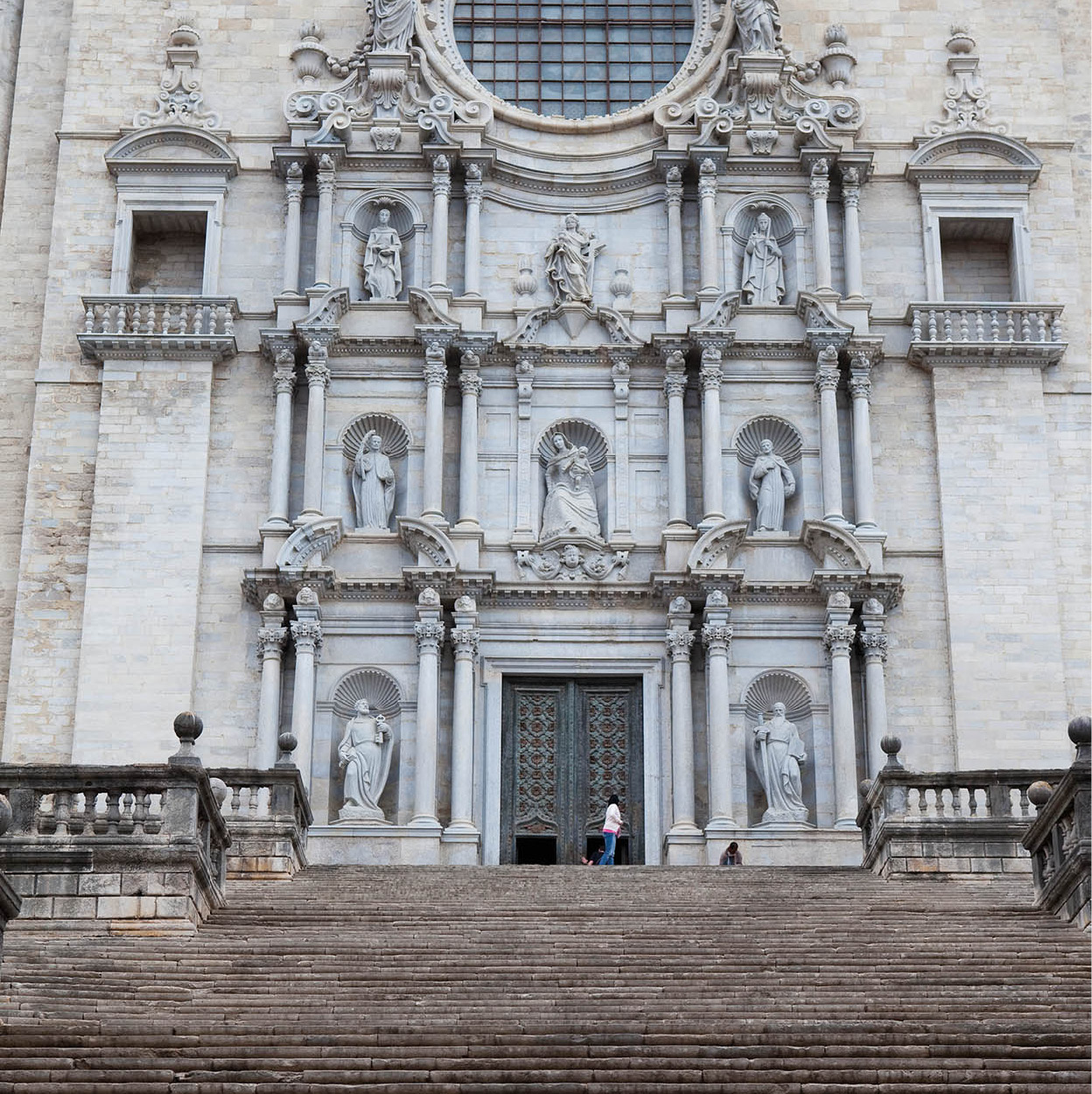
Steps up to the cathedral nave, Girona.
Corrie Wingate/Apa Publications
Santa Maria Cathedral
Opening Hrs: Visit includes the museum; Mon–Sat summer 10am–7.30pm, winter 10am–6.30pm, Sun all year Treasury and Cloisters only, 10am–2pm
Entrance fee: charge (free on Sun)
Described by Josep Pla as ‘literally sensational’, Girona’s cathedral was built by Guillem Bofill, who covered the structure with Europe’s largest Gothic vault. It includes several treasures, the most notable being the Tapis de la Creació, a stunning 12th-century tapestry depicting God surrounded by all the flora and fauna, fish and fowl of Creation. Equally impressive is Beatus’s Llibre de l’Apocalipsi (Book of the Apocalypse), dated 975.
The Església de Sant Feliu, the Arab Baths and the Call, with its Museum of Jewish History (summer Mon–Sat 10am–8pm, Sun 10am–2pm, winter Tue–Sat 10am–6pm, Sun–Mon 10am–2pm; charge), are other important landmarks of this ancient city.
Eat
Figueres has many good restaurants. Hotel Empordà, on the outskirts of town, has one of Catalonia’s most famous restaurants (for more information, click here).

In the Teatre-Museu Dalí.
Gregory Wrona/Apa Publications
Figueres ! [map]
Figueres, another half-hour north on the AP7 motorway, is the major city of the Alt Empordà. The Rambla is the scene of the traditional passeig, the midday or evening stroll.
Teatre-Museu Dalí
Address: Plaça Gala-Salvador Dalí, 5; www.salvador-dali.org
Opening Hrs: July–Sept daily 9am–8pm, Oct–June Tue–Sun, times vary so check website
Entrance fee: charge
Figueres is best known as the birthplace of the Surrealist artist Salvador Dalí, whose museum is aptly located in the former municipal theatre. This is one of the most visited museums in Spain and has a wide range of Dalí’s work, including the Poetry of America, painted in 1943, a portrait of his wife Gala as Atomic Leda, and the huge ceiling fresco dominating the Wind Palace Room on the first floor. Whether you regard him as a genius or not, there is no denying that this museum, with its tricks and illusions, provides an entertaining show.
A new space, Dalí.Joies (entrance charge, or entry with ticket to main museum), in an annexe, exhibits 37 pieces of jewellery by Dalí and sketched designs.
Figueres is a good base for Dalí tourism in the region: both Dalí’s house in Port Lligat, near Cadaqués, and the castle he bought for his wife, in Púbol, are open to the public (for more information, click here).
Salvador Dalí
Through the endeavours of the Gala-Salvador Dalí Foundation, the surreal world of Dalí now includes his home in Port Lligat, his wife Gala’s castle in Púbol and the museum in Figueres. To get a broad view of the art and a vivid idea of the man, the best introduction is the Teatre-Museu Dalí. Some 30km (20 miles) away on the coast, near Cadaqués, is the Casa-Museu Salvador Dalí, giving a fascinating glimpse of Dalí’s life. These old fishermen’s cottages have limited space, so small groups are admitted every 10 minutes. It is essential to book in advance and obey strict rules (check website for the conditions; tel: 972-251 015; www.salvador-dali.org; summer daily 9.30am–9pm, winter Tue–Sun 10.30am–6pm, closed Jan–early Feb). Bought by Dalí for his wife in 1970, the Castell Gala Dalí is atmospheric, set in a landscaped garden in Púbol in the Baix Empordà district (summer daily 10am–8pm, winter Tue–Sat 10am–5pm, closed Jan–mid-Mar).
Costa del Maresme
The beaches just north of Barcelona have a much lower profile than Sitges, and are much maligned for the railway line that runs alongside them. As a result, they are often less crowded. In recent years most have been overhauled, with some beaches being widened, promenades landscaped and marinas built. It is worth travelling beyond Badalona, though its promenade is a pleasant place for lunch. However, if you only have half a day, both Masnou and Vilassar de Mar are very acceptable, with xiringuitos (snack bars) on the beach.
Caldes d’Estrac @ [map]
One of the most attractive resorts is Caldes d’Estrac, also known as Caldetes. The slightly longer journey – about 40 minutes from Barcelona by car on the speedy C32 and about 45 minutes on the train from Plaça de Catalunya – is well rewarded. Caldetes is a spa town – several hotels have thermal baths – and it has many pretty modernista houses. The long, sandy beaches never get too crowded, and the sea is usually clear.
Early evening is a particularly pleasant time, when families dress up in smart-casual clothes to promenade and have a drink on the esplanade, or an ice cream on the seafront. You can enjoy all this, have dinner and get back to Barcelona for the night without too much effort.
Seaside villages
The beaches of Caldetes merge with those of Arenys de Mar, known for its attractive fishing port and famous restaurant, the Hispania, favoured by King Juan Carlos (for more information, click here).
The next town north, Canet de Mar, has a refurbished waterfront and interesting 19th-century architecture. The home of Lluís Domènech i Montaner (for more information, click here), one of the leading modernista architects in Barcelona, can be visited (Tue–Sun 10am–2pm; Fri–Sat also 5–8pm; closed last weekend of month; charge).
Just beyond Canet de Mar is Sant Pol, a pretty, whitewashed village.

The castle at Tossa de Mar.
Corrie Wingate/Apa Publications
The Costa Brava
To get away entirely from city beaches it is worth going as far as the Costa Brava. The southernmost parts of this rocky coastline (brava) can be reached in a day, like Blanes £ [map],where it officially begins. However, with more time you can get further north to the really magical parts, from Tossa de Mar up to the French border. Most of these places can be reached by bus from Estació del Nord bus station, though it is well worth renting a car to allow maximum freedom to explore.
The beaches and medieval inland villages of the area known as El Baix Empordà were until recently a well-kept secret. Some of the villages have been prettified, their honey-coloured houses tastefully renovated by middle-class weekenders from Barcelona, but they remain endlessly charming. A good base could be Begur $ [map], a pretty hilltop village with a cosmopolitan edge, just inland from some of the prettiest calas (sandy inlets) that punctuate the rocky coastline. You will be spoilt for choice between the sheltered cove of Tamariu, lined with seafood restaurants, the clear azure of the different bays of Aigua Blava or the atmosphere of generations of family summers in Sa Riera.
